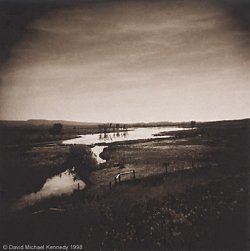
Cows roam randomly over dirt roads. It's a long way from Broadway. David Michael Kennedy life is too short to fritter it away in a place where he can not fulfill his dreams-even if he's making a bundle of money. A top celebrity photographer in New York for 18 years, with numerous CEBA and CLIO awards under his belt, Kennedy gave up his album covers, posters, and major editorial work, burned his bridges and headed for New Mexico, the land of enchantment.
Raised in northern California, Kennedy went to New York in the early 1970s to have back surgery and stayed for close to 20 years. "I kept meeting more interesting people and getting more interesting jobs," he says, "and I had a tremendous amount of freedom in my work. A client might send me a tape of Muddy Waters and say, "listen to it and make a photo of him." The photograph of a mellow, smiling Muddy Waters was followed by Bruce Springsteen quietly seated at the far end of a kitchen table, Isaac Stern peeking mischievously from behind his violin, Willie Nelson, baseball's Mickey Mantle, and numerous other notables.
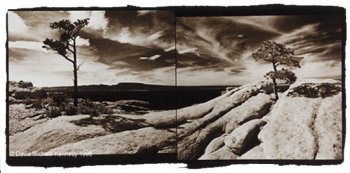
|
|
reprinted with permission of:
Shutterbug Magazine
www.shutterbugmagazine.com
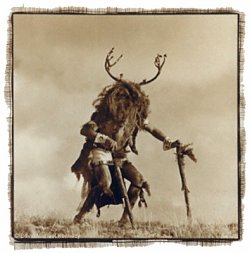 In 1987 Kennedy realized that he had reached a plateau and knew that if he was going to stay in New York he would need to expand his business, hire more people, and climb to the next rung of the ladder. "You can't stay where you are in New York," he says. "You're either going up or going down and things were starting to get comfortable. For an artist, that is dangerous. I realized how far removed I was from the actual photo world. I don't understand the collector mentality, the art world pricing, the hype, the incredibly beautiful work that nobody ever buys, and the garbage that's sold for $20,000 to $30,000. I didn't fit into that world being part photographer, part businessman, and part PR person. I wanted to make photographs for myself- landscapes, clouds, mountains..." In 1987 Kennedy realized that he had reached a plateau and knew that if he was going to stay in New York he would need to expand his business, hire more people, and climb to the next rung of the ladder. "You can't stay where you are in New York," he says. "You're either going up or going down and things were starting to get comfortable. For an artist, that is dangerous. I realized how far removed I was from the actual photo world. I don't understand the collector mentality, the art world pricing, the hype, the incredibly beautiful work that nobody ever buys, and the garbage that's sold for $20,000 to $30,000. I didn't fit into that world being part photographer, part businessman, and part PR person. I wanted to make photographs for myself- landscapes, clouds, mountains..."
So Kennedy and his wife Lucy, a native New Yorker, drove across the country and made some major life decisions. A 100 year-old house in the remote village of Cerrillos, New Mexico, soon became home and despite the $200,000 drop in income the first year, Kennedy could photograph what he loved. Within a short time his work was represented in the Andrew Smith Gallery and other fine galleries in and around Santa Fe and he was invited to teach landscape and portrait photography at the Santa Fe Photographic Workshop. He also taught platinum printing on a one- to-one basic, the fortunate student residing in his home.
"The move to this little dirt town was the scariest thing we could do," he recalls. "The place looked like an old West mining town and we would wake up in the morning and find cows on our front porch. Two and a half years ago we moved a little closer to Santa Fe on Highway 14 since we have to drive our son to school in Santa Fe every day and we needed more space and bigger darkroom facilities."
|
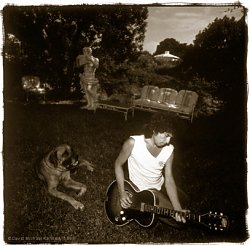
Kennedy's fine art business is rapidly growing and he works daily, in the darkroom or out shooting. Many days start at 6am and end at 10 or 11 at night but he would never sacrifice any of this time to do something else to support himself. His wife does all the matting and framing and an assistant lives in the guesthouse on the property while their director of sales, marketing, and special projects, takes care of the business end of things.
All of Kennedy's prints are platinum/palladium. The rich warm- toned images, each one made laboriously by hand, are bordered by painterly brush strokes. "I love the color quality and feel of platinum/palladium that I am notable to achieve with silver," he says, "and the fact that my prints are totally handmade means a great deal to me. I coat every sheet of paper that we print on and we mix all our own chemicals. Each print is an individual thing."
Kennedy recalls how when printing silver he could make a hundred prints in a day and know that each one would be satisfactory. With the platinum process if he is able to do 10 prints in a day it's a lot. "I believe there's much mysticism in this process", he says. "Things go wrong and you can't explain why. I try to approach a problem scientifically and often can't find the reason for the problem. Then, all of a sudden the problem disappears. There's magic and karma and spirit involved and that's why I love it so much."
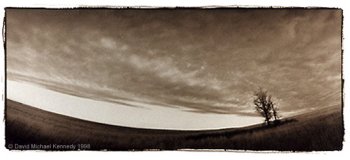
|
|
|
|
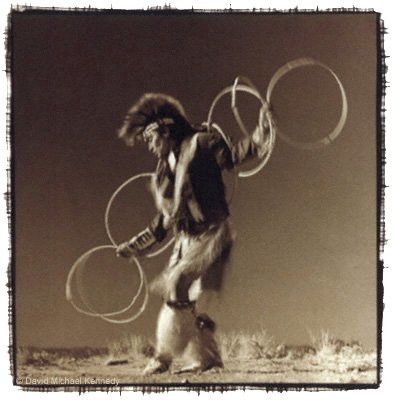
Some of Kennedy's most powerful images are those of Native American dancers. In 1989 he became dedicated to American Indian causes after an assignment for Penthouse magazine introduced him to American Indian activist Leonard Peltier who was incarcerated for life in Leavenworth Penitentiary by the US government. Peltier's spirit moved Kennedy to devote a part of his photographic income to aid American Indian causes. As he grew deeper into the culture he met many Native Americans and began to photograph dancers, a subject rarely witnessed, much less photographed, by an outsider. Ancient rhythms, feathers whirling, one critic described Kennedy's image of a Lakota coyote dancer as "a motion charged symphony of man, feathers, and fur."
Kennedy's portraits of celebrities, Native Americans just plain "folk," show the intimate and trusting relationship he is able to form with his subject. One of his favorite images was taken in Lincoln, Nebraska, of 87-year-old Bessie May Whitlatch who welds handlebars for Kawasaki motorcycles- "a really cool lady," Kennedy recalls. There was Bob Dylan who made it clear that he would allow the photo shoot in his backyard if there were not a whole entourage. So Kennedy went alone. He told Dylan that he would have to help him unload and Dylan agreed, going up on a ladder himself to unload the background for the shoot. "We were just two guys making a picture." In the landscapes the same purity and perfection prevails, again Kennedy focusing on something that has touched him and in turn speaks to the viewer.
His most significant influence has been Irving Penn. "He blows mind," Kennedy says. "Penn brings a piece of himself to every photograph and is incredibly successful in doing what I am attempting to do. He has a tremendous respect for his subjects, though Georgia O'Keefe wrote him a nasty letter because he photographed her way off at a distance and she came out teeny."
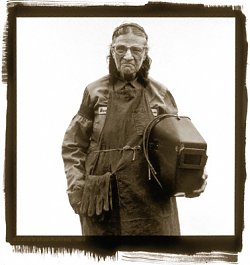
"I look for the positive in my subjects," Kennedy explains, "unlike the series that Richard Avedon did in the American West series. I admire Avedon greatly but I think in that work he looked for the awkward moment in his subjects when they felt insecure, unsure. (Of course I did do a portrait of Mike Tyson where I flipped two negatives so it is a very two-faced image.")
Along with the convincing feeling he wants to convey, Kennedy looks to the technical execution as well. "It takes both to make a good photograph," he says. "When I look at an image it must call out to me, make me stop and want to look and understand what is there and what I am being shown. I'm not a Zone System guy, not into the f/64 technical perfection, and I see lots of prints that are technically perfect with all the zones but they're boring, simply a good technical exercise. Everything in a print must marry-the vision, the technique, and the imagery, so it works as a complete unit. Whether it is a Zone System full toned print like John Sexton's or something as different as what Man Ray did, their techniques work beautifully with their images"
Kennedy shoots with a 10-year old Nikon F3 and a 30-year-old Hasselblad that he bought from Ken Hansen in New York. "I told Hansen I was opening a studio and didn't have any money and he took a hundred bucks cash and gave me a complete Hasselblad system. Each month I would pay him what I could and paid for the equipment out over a five-year period. I still thank him. I also use a Pentax 67 for landscapes as well as a 4x5 Star D SLR made in the 1940s, a fabulous camera."
David Michael Kennedy has a goal. "I don't want my pictures on museum walls or in collectors' boxes and I'm not interested in making millions of dollars. I'm interested in making photographs and the biggest rush for me is that people are waking up and as they are having their coffee or walking through their conference rooms and living their lives, they are seeing my pictures. And I hope they are speaking to them."
To view more of Kennedy's images visit his web site at: www.davidmichaelkennedy.com
|
|
